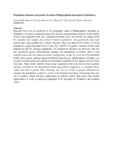Please use this identifier to cite or link to this item:
https://cris.library.msu.ac.zw//handle/11408/3224Full metadata record
| DC Field | Value | Language |
|---|---|---|
| dc.contributor.advisor | ||
| dc.contributor.author | Sungirai, Marvelous | |
| dc.contributor.author | Baron, Samantha | |
| dc.contributor.author | Van der Merwe, Nicolaas A. | |
| dc.contributor.author | De Clercq, Patrick | |
| dc.contributor.author | Maritz-Olivier, Christine | |
| dc.contributor.author | Madder, Maxime | |
| dc.date.accessioned | 2018-10-02T10:17:23Z | |
| dc.date.available | 2018-10-02T10:17:23Z | |
| dc.date.issued | 2018 | |
| dc.identifier.issn | 0001-706X | |
| dc.identifier.uri | http://hdl.handle.net/11408/3224 | |
| dc.description.abstract | Recently there was an expansion in the geographic range of Rhipicephalus microplus in Zimbabwe. In order to understand gene flow patterns and population structure in this highly invasive and adaptable cattle tick, a population genetics study was carried out. Eighty-seven R. microplus tick samples drawn from 5 distinct populations were genotyped using eight polymorphic microsatellite loci. Genetic diversity (He) was high (0.755-0.802) in all the populations, suggesting high levels of gene flow with 97% of genetic variation found within populations and 3% amongst populations. No isolation by distance was observed with low but significant genetic differentiation amongst the populations (0-0.076). Most of the sampled individuals had admixed genetic backgrounds, except for those from Matabeleland North whose genetic makeup appeared different from the rest. Rhipicephalus microplus was recently recorded in this area and the environmental conditions do not support survival of the tick there. These results confirm recent range expansion of the tick and the lowest genetic diversity recorded in the Matabeleland North population is suggestive of a founder effect, which may lead to genetic drift. Generally, the very low levels of genetic differentiation amongst the populations could be a result of the frequent movement of livestock from one area to another, which will have implications for disease control. This study offers further opportunities to study evolutionary adaptation of R. microplus in Zimbabwe and southern Africa. | en_US |
| dc.description.uri | https://doi.org/10.1016/j.actatropica.2018.01.003 | |
| dc.language.iso | en | en_US |
| dc.publisher | Elsevier | en_US |
| dc.relation.ispartofseries | Acta Tropica;Vol. 180: p. 42-46 | |
| dc.subject | Rhipicephalus microplus | en_US |
| dc.subject | Population genetics | en_US |
| dc.subject | Microsatellites | en_US |
| dc.title | Population structure and genetic diversity of Rhipicephalus microplus in Zimbabwe | en_US |
| dc.type | Article | en_US |
| item.fulltext | With Fulltext | - |
| item.grantfulltext | open | - |
| item.openairetype | Article | - |
| item.cerifentitytype | Publications | - |
| item.languageiso639-1 | en | - |
| item.openairecristype | http://purl.org/coar/resource_type/c_18cf | - |
| Appears in Collections: | Research Papers | |
Files in This Item:
| File | Description | Size | Format | |
|---|---|---|---|---|
| Population structure and genetic diversity of Rhipicephalus microplus in Zimbabwe.pdf | Abstract | 108.47 kB | Adobe PDF |  View/Open |
Page view(s)
182
checked on Nov 23, 2025
Download(s)
26
checked on Nov 23, 2025
Google ScholarTM
Check
Items in MSUIR are protected by copyright, with all rights reserved, unless otherwise indicated.



